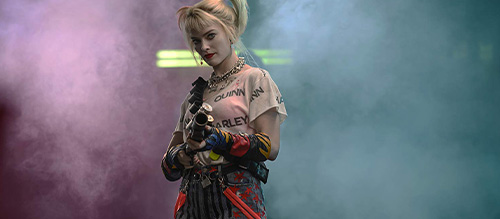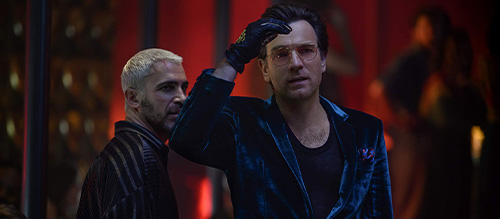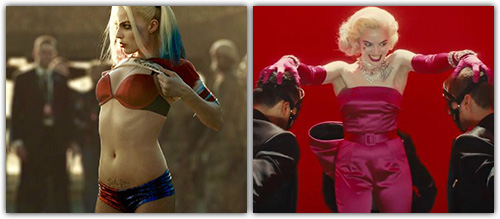How Cathy Yan’s ‘Birds of Prey’ Reawakens the Ethos of the Riot Grrrl
This article was written exclusively for The Film Magazine by Leoni Horton of Leoni Horton Movies.
‘That girl thinks she’s the Queen of the neighbourhood, I got news for you, she is!’ sang Kathleen Hanna, lead singer of Bikini Kill and prominent pioneer of the Riot Grrrl movement. It’s a lyric which precisely illustrates the message of Cathy Yan’s Birds of Prey and its fresh attempts to validate female anger.
The Riot Grrrl sub-culture snatched a space for female-led music in the Seattle grunge scene and birthed the ideology of the rebel girl. Their manifesto insisted that despite the status quo, women can be dirty, loud, vibrant and selfish, and it encouraged women to fight the system of oppression which brands them as the inferior sex. Their mission to normalise female anger was only getting started when they were pushed to the side by the likes of the Spice Girls and their subdued version of Girl Power. Although aspects of the culture lived on, the Riot Grrrl ethos all but disappeared from popular culture. With Birds of Prey (and The Fantabulous Emancipation of One Harley Quinn) the movement has, however, found a new voice through the medium of cinema.
Birds of Prey picks up where the Riot Grrrls left off, once again championing a woman’s prerogative to get angry. After years of having us make-do with Black Widow, the once male-centric comic book fandoms have gradually opened up their multi-verses to the concept of women. Wonder Woman and Captain Marvel revolutionised the game when they arrived on screen, both offering us strong female-centred narratives with protagonists who share undeniable power and unwavering no-nonsense attitudes. Although inspiring in their own ways, the heroes became slaves to the absolute goodness expected of women and, subsequently, their striking lack of faults made them feel cold, obvious and lacking. In direct opposition to the concept of the good girl, Cathy Yan gives us Harley Quinn, Black Canary, Huntress, Renne Montoya and Cassandra Cain, women who are entirely self-serving, untrustworthy and downright mean. These multifaceted women and their explicit dismissal of virtue awaken the fading message of female rebellion.
As her first act of rebellion, Quinn mimics the Riot Grrrls and even The Suffragettes when she uses public disorder to amplify her demands for independence. By blowing ACE Chemicals sky high, Quinn destroys the symbol of her enslavement to Joker and the over-sexualised version of her we came to know in Suicide Squad. Yan utilises Quinn’s unapologetic anger and reckless behaviour in a whole new way, ensuring she drops the Pretty Psycho routine and morphing her into a binge drinking, foul-mouthed rebel girl, who refuses to restrain herself or adapt to the tone of her circumstances. Instead of learning to straighten out her imperfect personality, Quinn uses her anger to seize back her agency from the confines of a male-dominated society and cuts her own slice of Gotham City.
Although Roman Sionis alone doesn’t particularly make for a formidable antagonist, his place within the hierarchy of Gotham means he can manipulate the majority of its inhabitants into obeying his every command. He uses this power to create a hold over Black Canary, which becomes particularly concerning when he shows himself capable of sexual violence. By choosing to oppose him, Harley Quinn and The Birds Of Prey take a stance against the same fear-based tyranny the Riot Grrrls organised against.
In one scene, we see lead henchman Victor Zsasz grab Quinn’s paralysed face and force her to mime the words ‘I’m a good girl’, the moment serving to express man’s obsession with the submissive role of the good girl. Quinn and The Birds Of Prey combat this ideology with violence, physically attacking any man who dares try to have them conform to this damaging narrative. Alternative readings of the film may confuse this behaviour as man-hating, anarchistic feminism, but this is not the case – Quinn and The Birds Of Prey only use violence under threat. Although his actions were just as cutting, the man who betrays Quinn’s friendship gets away unscathed. Yan puts varying forms of derogatory behaviour on display so audiences might recognise that it is more than violence which contributes to the controlling structures of a patriarchal society.
Of course, we can’t discuss the Riot Grrrl movement without referencing music. The brash lyrics of Riot Grrrl existing in songs such as “Dead Men Don’t Rape”, “Dig Me Out” and “Feels Blind” confront the code of silence which allows women to be trivialised, objectified and harmed. Every song on the female-dominated soundtrack of Birds of Prey uses the violent, heavy and sinister tones of Riot Grrrl to stir up the same rebellious energy. ‘Lock up your sons, make way for the daughters, you’ll be the lamb and we’ll be the slaughterer’ sings Halsey in “Experiment On Me”, shouting her lyrics bluntly as if the point she’s making should be obvious. ‘No more Mrs Shut Up and Smile, time for Mrs Takin’ What’s Mine’ adds Maisie Peters in “Smile”, exaggerating the desire for revolution. These antagonistic lyrics pitted against the accessible melodies of pop finally bring the Riot Grrrl message into the mainstream.
This is a man’s world, but it means nothing without a woman or a girl’ sings Black Canary in her rendition of the James Brown classic, summing up the thematic purpose of the film and highlighting the ingrained sexism existing in Gotham. Although Quinn and Montana are the antitheses of one another, they share a hatred for the ultra-masculine hierarchy of both the law and crime which has robbed them of their greatest achievements. The girls of this film don’t support each other because the Spice Girls held up peace signs and told women they should all be friends; they unite because despite their many differences they know they will be stronger together – if you wait for permission to claim the space you know belongs to you, you might never get it. The Riot Grrrls knew this, and so they took space for themselves. However, the revival movement of Birds of Prey adds a message of inclusion to the women who felt unrepresented by the punk movement. Three out of five of our main protagonists are women of colour, and at least one is a member of the LGBT community, their diversity revealing how patriarchal dominance is a problem all women are trapped beneath. If we are to create this space, then we must include the voices of every woman.
The ‘Daddy’s Little Monster’ slogan spread tightly over Harley Quinn’s chest in the seemingly never-ending horror show that constituted Suicide Squad, visually announced her as a man’s property. In Bikini Kill’s song “Daddy’s Lil Girl”, lead singer Hanna screams the lyric ‘Daddy’s girl, don’t wanna be his whore no more’, a lyric which perfectly encapsulates the new attitude towards Quinn’s portrayal in the DC universe. The low riding short shorts and relentless desire to serve any man she happened to spend more than five minutes in the company of, painted her as a character created by and for men. By reimagining the iconography in Birds of Prey, Yan liberates Quinn from the male gaze and gives her to the girls. Instead of hyper-sexualising her outfits, costume designer Erin Benach dresses Quinn in high waisted shorts long enough to cover her modesty and gives her a dynamic colour palate expertly capturing Harley’s loud and vibrant personality. Riot Grrrls famously gave each other bad haircuts to oppose normalised beauty standards, and likewise does Quinn jaggedly snip away her iconic pigtails in resistance of her toxic past.
Like Riot Grrrl band 7 Year Bitch, Benach was also able to highlight the over-sexualised imagery of Marilyn Monroe by recreating her infamous Gentlemen Prefer Blondes dress as a pink jumpsuit. Feminism has a rich history with pants, they became popular dress when women entered the workplace during the second world war, and subsequently became a symbol of female liberation and independence. By juxtaposing the dress with a pantsuit, Benach and Yan symbolically oppose the over-sexualised portrayal of women in film and give Quinn her coveted emancipation.
The reckless discourse of both The Riot Grrrl movement and Birds of Prey might appear to be encouraging women to lie, cheat, steal or even murder, but this is just spectacle; they are not asking women to be bad people. The movie challenges us to unapologetically own the flaws and chase the desires society encourages us to repress. It demands us to take the space we deserve by any means necessary. Despite proclaiming herself as one in Suicide Squad, Harley Quinn is not a bad guy.
She’s a bad girl.
Written by Leoni Horton
You can support Leoni in the following places:
Twitter: @inoelshikari
Blog: Leoni Horton Movies




